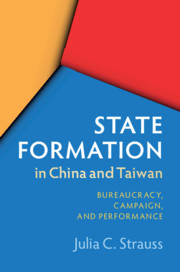Book contents
- State Formation in China and Taiwan
- State Formation in China and Taiwan
- Copyright page
- Dedication
- Contents
- Figures
- Acknowledgments
- Introduction
- 1 Virtue and Talent in Making Chinese States
- 2 Comparative Terror in Regime Consolidation
- 3 Performing Terror
- 4 Repertoires of Land Reform Campaigns in Sunan and Taiwan, 1950–1954
- 5 Theaters of Land Reform
- Conclusion
- Book part
- Documentary Collections, Reports, and Periodicals
- Bibliography
- Index
Introduction
Modalities of State Building and Institution Building: Bureaucracies, Campaigns, and Performance
Published online by Cambridge University Press: 13 October 2019
- State Formation in China and Taiwan
- State Formation in China and Taiwan
- Copyright page
- Dedication
- Contents
- Figures
- Acknowledgments
- Introduction
- 1 Virtue and Talent in Making Chinese States
- 2 Comparative Terror in Regime Consolidation
- 3 Performing Terror
- 4 Repertoires of Land Reform Campaigns in Sunan and Taiwan, 1950–1954
- 5 Theaters of Land Reform
- Conclusion
- Book part
- Documentary Collections, Reports, and Periodicals
- Bibliography
- Index
Summary
After presenting the fundamentals of Weberian-institutionalist and Gramsciian-culturalist approaches to understanding the state, this introduction suggests that it is possible to combine the two. Focusing on the unusually successful cases of state building of the “revolutionary” People’s Republic of China in Sunan and the “conservative” Republic of China in Taiwan in the early 1950s, it suggests that the “hows” of state building policy implementation are as important as the “whats.” Both regimes resorted to overlapping and shifting modalities of bureaucratic rule making and campaign mobilization, differing substantively in how these repertoires were performed and communicated to citizens at large.
- Type
- Chapter
- Information
- State Formation in China and TaiwanBureaucracy, Campaign, and Performance, pp. 1 - 33Publisher: Cambridge University PressPrint publication year: 2019

